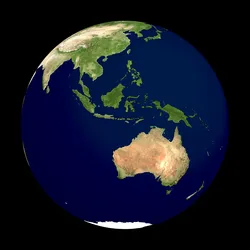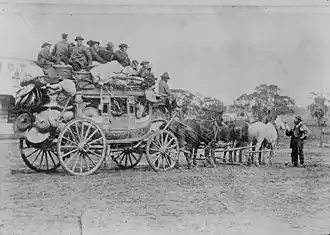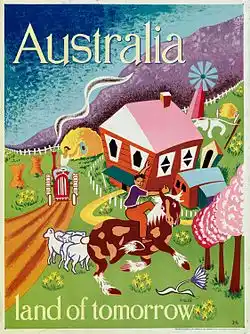Australia is a land of immigrants. Of course, it is home to Australia’s “First Peoples”, the indigenous Aborigines and Torres Strait Islanders. They are generally recognized as the world’s oldest continuous civilizations. But since the first British settlement in 1788, Australia has experienced wave after wave of immigrants. They have powered the country’s development and population growth, creating today's multicultural society.
Research your ancestors on MyHeritage
An ethnic mix built on immigrationAn ethnic mix built on immigration

Initially, these immigrants were from the United Kingdom and Ireland. They were convicts and prison guards who founded a colony in eastern Australia they called "New South Wales". Later they were joined by British free settlers, many of whom flocked to newly established colonies in Victoria, South and Western Australia. Then the mid-19th Century saw the influx of significant numbers from Ireland, escaping famine, as well as immigrants from China, drawn by the lure of newly discovered goldfields. The Chinese had to deal with overt discrimination under government policies designed to preserve a “White Australia", a policy which persisted until the 1960s.
People from all over Europe — at first mainly from Northern Europe — followed in the years leading up to World War I. Their numbers expanded very rapidly after World War II with the inclusion of Southern and Eastern European immigrants. These migrants took advantage of generous incentives, such as heavily subsidized passage, driven by the government’s concern that Australia had to “populate or perish”. Finally, starting in the 1970s, large numbers of Asian migrants came from Vietnam, India, Sri Lanka, Korea and China, joined more recently by refugees re-settled from the Middle East and Africa.
Today around 30% of Australia’s population was born overseas. Close to 50% have a parent who was overseas-born[1].
Indigenous AustraliaIndigenous Australia
Australia's indigenous peoples are made up of Aborigines, the original inhabitants of the mainland and Torres Strait Islanders, the original inhabitants of the 274 small islands located just north of the continent[2]. They have lived in Australia for millennia, with estimates varying from 50,000 to more than 120,000 years. Aboriginal people were hunter-gathers leading a semi-nomadic life. They were dispersed among hundreds of "nations", each with their own language (or dialect) and cultural practices, but all sharing a close kinship to their respective lands and a deep spiritualism built around the natural environment[3]. Aboriginal peoples had no chiefs or other centralized institutions of social or political control[4].
Some estimates put the number of Aboriginal and Torres Strait peoples at the time of the first white settlement at around 750,000[5]. They were decimated as a result of introduced diseases such as smallpox and the destruction of their traditional way of life by colonists who showed no awareness of, or interest in, its preservation.

By the late 19th century, and accelerating in the first half of the 20th century, government policies focused on the assimilation of Aboriginal and Torres Strait peoples into white society, driven by the belief that theirs was a dying culture. Aborigines were pushed onto reserves and children, especially those of mixed descent, were forcibly removed from their family groups[4].
Attitudes began to change in the second half of the 20th century. In recent decades there has been an even more dramatic shift, with a widespread acknowledgment of the hugely destructive impact of past policies towards these First Peoples and regular positive acknowledgement of their culture in the media and everyday life. But Aboriginal and Torres Strait peoples remain seriously disadvantaged across all socioeconomic measures. Major programs aimed at "Closing the Gap" have made limited progress[6].
Today a little over 3% of Australia's population identify as Aborigines or Torres Strait islanders[7].
Convict, British and Irish AustraliaConvict, British and Irish Australia
Between 1788 and 1868 more than 162,000 convicts were transported to Australia as punishment for what today we would regard as petty crimes. Britain’s jails were overflowing and the option of transportation to the Americas disappeared following the War of Independence. In Australia the lives of convicts were hard, but their work provided the foundation of the young colony[8]. The vast majority worked for the government or free settlers and, with good behavior, they could earn a “ticket of leave”, a form of early conditional pardon. Most stayed in Australia, and some became successful and wealthy settlers.
Until perhaps 50 years ago most Australians would have been embarrassed to discover that any of their ancestors were “criminals”. But that attitude has completely reversed. Today family researchers are proud when they can trace their lineage back to convicts, especially those who arrived in the very first days of the colony (the “First Fleeters”).

Even before convict transportation ceased in the 1860s British free settlers flocked to the Australian colonies in search of a better life and a fresh start. Young single women came voluntarily (usually sponsored by relatives) or were brought forcibly as prospective brides. Poor British children were rounded up by the authorities and shipped to the colonies, usually without their parents' knowledge or consent.
Meanwhile, a steady number of settlers from Ireland continued to arrive, with a spurt in the mid-19th century. These settlers were motivated by severe economic conditions in Ireland and the American Civil War and its aftermath which made migration to the United States less appealing. By 1870 the Irish-born represented a quarter of the Australian population[9]. As Australia prospered Britain and Ireland remained the largest single source of migrants. This continued until the late 1940s, bolstered by various assisted migration schemes introduced after 1918. Even today, many Australians have English, Scottish, Welsh or Irish ancestry. And as late as the 1950s many Australians would continue to refer to Britain as the "mother country", still fondly attached to Australia's place in its rapidly vanishing Empire.
Asian and Pacific AustraliaAsian and Pacific Australia
Chinese immigrants represented the first significant non-indigenous, non-British community in the Australian colonies. Small numbers began arriving soon after British settlement in 1788. The importation of Chinese indentured laborers began in the 1840s in response to severe labor shortages in the colonies. In the two decades thereafter their numbers grew rapidly as news spread overseas of gold discoveries. It is estimated that from 1853 up to 40,000 Chinese arrived to work in the Victorian goldfields, lured by hardship at home. Few actually struck it rich. Some returned to China but many others stayed in Australia[10].

Despite facing significant resentment from European settlers, who felt that the Chinese depressed wages and work conditions, their number continued to grow even after the gold rush had petered out by the 1870s. But in 1901 a new Immigration Act was enacted. It included a language dictation test specifically designed to make it virtually impossible for non-Europeans to gain entry to Australia. It was a cornerstone of the "White Australia Policy"[11].
Despite their prominence in many facets of Australia's economy and society, the local Chinese community continued to face much overt and covert discrimination well into the 20th century. One example relevant to family historians is the treatment of Australians of Chinese origin who sought to join the Australian military during World War I. Australian authorities had an inconsistent attitude towards the Chinese community. Chinese males were required to register as aliens. But some Australian-Chinese were able to successfully enlist in the military if they could establish that they were "substantially of white origin".
Others disguised their Chinese ancestry. For example one man with a Chinese grandfather, "Arthur Sam", was rejected in his first attempt to enlist in 1915 despite recording his name as "Arthur Sams" and giving his Anglo mother as next-of-kin on his enlistment form. But on his second attempt, this time giving his name as "Arthur Sands", he was accepted[12]. Similar situations meant Chinese fathers had to report to the police to register as aliens while their Australian-born sons were overseas fighting on behalf of the country and the British Empire[13].
Attitudes changed over the course of the 20th century as Australia became increasingly multicultural. After World War II ethnic Chinese students from Malaysia and Singapore arrived in big numbers under Australian programs designed to foster closer ties to Asia. Many stayed and later sponsored their family members to migrate. Following Australia's recognition of the People's Republic of China in 1972 mainland Chinese students also started to come. Tens of thousands of these were permitted to stay permanently following the Tiananmen Square crackdown in 1989. Then still more Chinese arrived from Hong Kong after the PRC resumed control in 1997. Today Australia is still a popular destination for Chinese students as well as for skilled workers and family migration[14].

Meanwhile, migrants from elsewhere in Asia started to increase sharply from the 1970s. Today the fourth largest migrant community in Australia is Indian-born. These are also substantial communities originating from Sri Lanka, Vietnam, Korea and various South East Asian countries. A notable exception is the very limited inflow of people from Australia's nearest Asian neighbour, Indonesia[15].
Since the 1920s there has been a free flow of people between Australia and New Zealand under various arrangements. As a result New Zealand has consistently been the major source country from the Oceania region, with much smaller numbers arriving from the islands of the South Pacific. However in recent years the Pacific islander population has been growing fast[16].
European and Refugee AustraliaEuropean and Refugee Australia
Just as the mid-1800s gold rush led to the arrival of large number of Chinese migrants it also saw the influx of 60,000 Europeans, mainly from Germany, Central Europe and the Nordic countries[17]. European migration continued in fits and starts throughout the first half of the 20th century then accelerated massively after World War II. The near invasion of Australia by Japan early on in the War led to a sharp change in government and popular attitudes towards migration, summed up in the concept of "Populate or Perish"[18].

Initially, Australia focused on providing assisted passage to British ex-servicemen and their families. But this was soon extended to include people from southern and eastern European countries as Australia found it could not attract enough Britons. Assisted arrivals in Australia increased rapidly thereafter, reaching 120,000 in 1949 alone when Australia’s total population was still less than eight million. For the millions "displaced" by WWII and desperate for a new life away from war-ravaged Europe Australia offered an attractive opportunity as it imposed much less onerous sponsorship and work requirements than similar schemes operating to other potential destinations such as the United States, Canada and various South American countries[19]. In less than two decades thereafter Australian society, up until then with a still strong British flavour, became truly multicultural.
As assisted mass migration programs began to wind down in the 1970s, there were new waves of refugee arrivals. Tens of thousands of Vietnamese were accepted on humanitarian grounds following the end of the Vietnam War in 1975. In the fifty years since then over 550,00 refugees have been re-settled in the wake of wars and natural disasters in their homelands across Asia, the Middle East and, most recently, sub-Saharan Africa[20].
Today, as a result of more than two centuries of immigration, Australia is made up of people who identify with more than 270 different ethnic groups[21] in a population of just under 26 million.
See alsoSee also
Explore more about Australian genealogyExplore more about Australian genealogy
MyHeritage provides various collections that can assist researchers to discover more about family who migrated to Australia and their origins:
- The Australia, South Australia, Adelaide Gaol Prisoner Registers, 1848-1912 collection includes records of individuals brought to Adelaide Gaol. The records typically contain the name of the individual and information about the original document.
- Australia, New South Wales, Gaol Inmates & Photos, 1870-1930. A unique collection contains information and images from the Gaol Photographic Description Books, which contains photographs of prisoners from several jails. The records typically include the name of the prisoner, year and place of birth, the date the portrait was taken, and the prisoner’s jail and number.
- The Oceania - Immigration & Travel Collection includes many passenger lists covering arrivals in Australian states over much of the 19th and 20th centuries, immigration records and some Australian citizenship records.
- The Oceania - Newspaper Collection includes almost 15 million text-searchable articles drawn from over 700 Australian newspapers. Newspaper articles can be an invaluable source of otherwise hard to find personal details and life stories.
- The Oceania - Histories, Memories & Biographies Collection consists of 23 collections of family histories, including historical "cyclopedias" from various Australian states providing information on their people, towns, industries, professional, commercial and social institutions etc.
- The Oceania - Census & Voter List includes historical voter rolls for most Australian states over different periods. Because voter registration in Australia is compulsory these lists can be a powerful way to track ancestors' location and movements over time.
- Family Trees created and maintained by other MyHeritage members offer an invaluable tool to find information on people of interest to you who appear in their trees.
- How to Research Your Ethnicity with Genealogy on the MyHeritage Genealogy Hub is a new resource worth checking out
Beyond MyHeritage resources, other useful general tools on Australian migration include:
- The Migration Heritage Centre's "Belongings" website has been archived and is no longer updated. However, it includes hundreds of stories of post-WWII migrants, searchable by name, place of departure and cultural background.
- Non-profit CoraWeb is a portal to a great collection of links for Australian family history researchers. These specialist databases cover everything from asylum and hospital records and criminal and court records to local history and shipping passenger lists.
ReferencesReferences
- ↑ “30% Of Australia's Population Born Overseas.” Australian Bureau of Statistics.
- ↑ Australian Institute of Aboriginal and Torres Strait Islander Studies. “Australia's First Peoples.” AIATSIS, Australian Institute of Aboriginal and Torres Strait Islander Studies, 15 Nov. 2022
- ↑ “60,000+ Years Ago to 1788.” History: 60,000 Years : Working with Indigenous Australians.
- ↑ 4.0 4.1 “Kinship, Marriage, and the Family.” Encyclopædia Britannica, Encyclopædia Britannica, Inc.
- ↑ “A Brief Aboriginal History - Aboriginal Heritage Office.” Aboriginal Heritage Office - for Ku-Ring-Gai, Lane Cove, Manly, North Sydney, Pittwater, Ryde, Warringah, Willoughby, 16 May 2022
- ↑ “Closing the Gap Targets and Outcomes.” Closing the Gap Targets and Outcomes | Closing the Gap.
- ↑ “Australia: Aboriginal and Torres Strait Islander Population Summary.” Australian Bureau of Statistics.
- ↑ “Convict Transportation Peaks.” National Museum of Australia, National Museum of Australia, 20 Sept. 2022.
- ↑ Community Information Summary - Ireland-Born - Home Affairs.
- ↑ Love, Alastair. “A Brief History of Chinese Migration to Australia.” The LOTE Agency, 1 Sept. 2022
- ↑ “White Australia Policy.” Wikipedia, Wikimedia Foundation, 7 Apr. 2023.
- ↑ Maurice, Daniel. “The Sam Family of Wyalong: Where Does It Fit in?”, Maurice-Robinson Family, 10 July 2021
- ↑ Loh, Morag, and J. Winternitz. Dinky-Di: The Contributions of Chinese Immigrants and Australians of Chinese Descent to Australia's Defence Forces and War Efforts 1899-1988. Australian Government Publishing Service, 1989.
- ↑ “Chinese Immigration to Australia and Chinese Australians.” The Australia-China Story
- ↑ West, John. “Asian Migration to Australia.” Asian Century Institute, 23 June 2015
- ↑ Huiyuan Liu, Stephen Howes. “Pacific Islanders in Australia: 2021 Census Results.” Devpolicy Blog from the Development Policy Centre, 13 Apr. 2023
- ↑ “Australia's Migration History.” NSW Migration Heritage Centre
- ↑ “Immigration History of Australia.” Wikipedia, Wikimedia Foundation, 29 Mar. 2023
- ↑ Maurice, Daniel. “A New Life as ‘New Australians.’” Maurice-Robinson Family, 8 July 2021
- ↑ “How Many Refugees Have Come to Australia?” Refugee Council of Australia, 31 Oct. 2022
- ↑ “Face the Facts: Cultural Diversity.” The Australian Human Rights Commission

